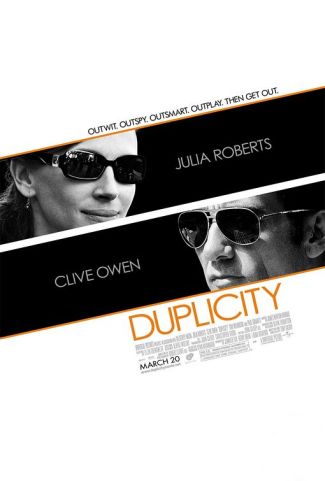On Beauty In Cinema

I'm a sucker for a beautiful image. I'll often overlook problems others see in a film if there's one image that sticks out as truly beautiful to me. That was the overpowering force that led me to love The Curious Case of Benjamin Button so much more than all those people whose opinion I often agree with (see this take on the film). It doesn't even have to be a particularly ambitious or grandiose shot to take my breath away. In Benjamin Button, it was Tilda Swinton's face. There is a scene in Button where Brad Pitt and Tilda Swinton are about to consummate their affair. They take the elevator up to her floor. In this midst of this sequence, there is a shot of Tilda's face, the brim of her hat barely peeking into the frame. The shadow of the brim covers her entire face. It's the sort of sublime close-up that is just rarely seen. From that moment on, I couldn't say I disliked the film.
It is with this perspective that I ended up drooling all over Duplicity. You would think this should come as no surprise to those familiar with the works of Academy Award Winning Cinematographer Robert Elswit. This is the man who photographed each of Paul Thomas Anderson's films, as well as Syriana and Good Night, and Good Luck. His previous work with director Tony Gilroy, Michael Clayton, earned Gilroy and Academy Award Nomination. Though everyone remembers that final shot, with Clooney in the cab driving nowhere as the credits roll, there was another image that struck me. A board room. A few men enter from the right. It seems simple, but that sort of shot is entirely about compositions, angles, and the proper use of space. In most films, that would be a throwaway shot, one not worth working on. Here, it becomes a work of art, another morsel to tantalize the viewers who are truly willing to see it. Most people will not notice it, distracted as they are with the mechanics of the plot of yet another legal thriller. But that image is still there.
If there's one scene that perfectly exhibits what this film is about, it is the opening credits. Two private planes land at a private airport in the rain. The passengers of each plane climb down the stairways, until the two important people exit the plane. You know they're the important people because they're Paul Giamatti and Tom Wilkinson. And as the credits begin to appear on the screen, these two Academy Award nominees begin to fight each other. This wrestling match is presented in slow motion, making this battle a ballet. You wonder at the beauty of these bodies flying through the air, the faces so extraordinarily stretched for comic effect. This is not a movie you should not take seriously. It is something you can sit back and enjoy, because you know you are in good hands. The ballet is rendered with such precision for the facial expressions and the portions of the screen left blank that you cannot help but stare in joyous wonder.
As you may have noticed by looking at a calendar, it is 2009. As you may have noticed by reading any number of film blogs on this here internet, that means it's been 70 years since the glory year of 1939. Of course, this gives us the opportunity to look down our noses at the modern film industry. The film industry we see in 2009 is nothing like it was 70 years ago, for better or for worse. The one constant in discussions of the old days is how great directors worked within the studio system to put their own individual marks on films with stars. In this way, Duplicity is quite possibly the closest we can get to the 30s. Gilroy and Elswit certainly know how to craft an image, and Julia Roberts and Clive Owen bring as much charm as they can manage to a light and breezy script. Forget the simplistically complex plot structure -- I need to give immense credit to Gilroy for stylistically separating each time period and storyline so easily and recognizably -- for just one second. This is a film more about the moment than anything else. As Odienator so perfectly stated about Ocean's 13, this is a film you should go to so you can have a good time. I think that was what did it in. People went in expecting a plot. The plot is there to adorn scenes of Julia Roberts in an American flag bikini and lines about how they finally managed to freeze pineapple for your pizza. The plot probably falls apart when you think about it too much, but I was too distracted to really think about it.
This is not a movie that asks you to shut your brain off. Despite what I said above, the film still asks you to think about what is going on in every scene and how it relates to everything else we've seen. The dialogue is amazingly witty, and I don't know if I've said enough about how this film engages your eyes before all else. But the film still works on multiple levels. You can focus on the images, the plot, or the dialogue. Whatever you want, this film has got it. This is the film I was waiting for all spring, and it's the film I never got this summer. It's a rare breed of film, one that shouldn't be lost to the discount rack of your local Best Buy.
Labels: Duplicity, Tony Gilroy


















